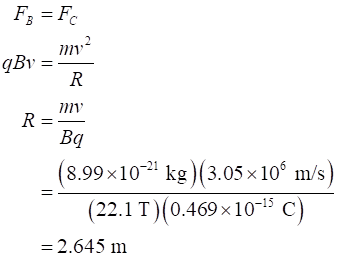Refer to diagram 1b. As in problem 1: an atomic particle of mass m = 8.99x10²21 kg, charge 0.469x10-15 c is shot southward at v = 3.05x106 m/s toward a vertical wall, and when the particle is distance d = 4.51 cm from the wall a magnetic field is turned on: it has magnitude 22.1 T and points upward. This time, however, the magnetic field is not strong enough to stop the particle from hitting the wall. Find x, the distance the particle is deflected to the west before it hits the wall, in mm. HINT: The force on the charge is not constant, since the direction changes; therefore, you cannot use kinematics!! This problem can be solved easily with a little geometry. QUESTION: You get two roots: which is the answer you seek, and what is the meaning of the other root?
Refer to diagram 1b. As in problem 1: an atomic particle of mass m = 8.99x10²21 kg, charge 0.469x10-15 c is shot southward at v = 3.05x106 m/s toward a vertical wall, and when the particle is distance d = 4.51 cm from the wall a magnetic field is turned on: it has magnitude 22.1 T and points upward. This time, however, the magnetic field is not strong enough to stop the particle from hitting the wall. Find x, the distance the particle is deflected to the west before it hits the wall, in mm. HINT: The force on the charge is not constant, since the direction changes; therefore, you cannot use kinematics!! This problem can be solved easily with a little geometry. QUESTION: You get two roots: which is the answer you seek, and what is the meaning of the other root?
College Physics
11th Edition
ISBN:9781305952300
Author:Raymond A. Serway, Chris Vuille
Publisher:Raymond A. Serway, Chris Vuille
Chapter1: Units, Trigonometry. And Vectors
Section: Chapter Questions
Problem 1CQ: Estimate the order of magnitude of the length, in meters, of each of the following; (a) a mouse, (b)...
Related questions
Question
Question in the attachment below

Transcribed Image Text:**Problem Statement:**
Refer to diagram 1b.
As in problem 1: an atomic particle of mass \( m = 8.99 \times 10^{-21} \) kg and charge \( 0.469 \times 10^{-15} \) C is shot southward at \( v = 3.05 \times 10^{6} \) m/s toward a vertical wall. When the particle is at a distance \( d = 4.51 \) cm from the wall, a magnetic field is turned on: it has a magnitude of 22.1 T and points upward. This time, however, the magnetic field is not strong enough to stop the particle from hitting the wall.
Find \( x \), the distance the particle is deflected to the west before it hits the wall, in mm.
**HINT:** The force on the charge is not constant, since the direction changes. Therefore, you cannot use kinematics! This problem can be solved easily with a little geometry.
**QUESTION:** You get two roots: which is the answer you seek, and what is the meaning of the other root?

Transcribed Image Text:The image consists of two diagrams, labeled Diagram 1a and Diagram 1b, which illustrate the concept of magnetic fields and forces.
**Diagram 1a:**
- The diagram features a coordinate compass indicating North (N), South (S), East (E), and West (W).
- A series of evenly distributed black dots represent a uniform magnetic field directed out of the page.
- A thick horizontal line simulates a conductive wire, and a dashed curved arrow originating from the wire indicates the direction of force exerted by the field on the wire.
- The variable \(d\) denotes the distance from the wire to the region where the force curves upward.
**Diagram 1b:**
- Similar to Diagram 1a, black dots indicate a uniform magnetic field coming out of the page.
- A horizontal line represents a conductive wire, with a dashed curve arrow indicating the force direction.
- The same variable \(d\) represents the vertical distance from the wire at the point where the force alters direction.
- An additional measurement \(x\) is marked, showing the horizontal distance from the wire to the point where the force begins to bend upward.
Both diagrams illustrate the effect of a magnetic field on a current-carrying wire, demonstrating the force direction as described by the right-hand rule and highlighting the influence of distance on magnetic interactions.
Expert Solution
Step 1
In the provided scenario, the magnetic field is perpendicular to the velocity. Thus, the motion of the atomic particle will be a circular motion. Therefore, the force equation along the radial direction be:

Step by step
Solved in 4 steps with 3 images

Knowledge Booster
Learn more about
Need a deep-dive on the concept behind this application? Look no further. Learn more about this topic, physics and related others by exploring similar questions and additional content below.Recommended textbooks for you

College Physics
Physics
ISBN:
9781305952300
Author:
Raymond A. Serway, Chris Vuille
Publisher:
Cengage Learning

University Physics (14th Edition)
Physics
ISBN:
9780133969290
Author:
Hugh D. Young, Roger A. Freedman
Publisher:
PEARSON

Introduction To Quantum Mechanics
Physics
ISBN:
9781107189638
Author:
Griffiths, David J., Schroeter, Darrell F.
Publisher:
Cambridge University Press

College Physics
Physics
ISBN:
9781305952300
Author:
Raymond A. Serway, Chris Vuille
Publisher:
Cengage Learning

University Physics (14th Edition)
Physics
ISBN:
9780133969290
Author:
Hugh D. Young, Roger A. Freedman
Publisher:
PEARSON

Introduction To Quantum Mechanics
Physics
ISBN:
9781107189638
Author:
Griffiths, David J., Schroeter, Darrell F.
Publisher:
Cambridge University Press

Physics for Scientists and Engineers
Physics
ISBN:
9781337553278
Author:
Raymond A. Serway, John W. Jewett
Publisher:
Cengage Learning

Lecture- Tutorials for Introductory Astronomy
Physics
ISBN:
9780321820464
Author:
Edward E. Prather, Tim P. Slater, Jeff P. Adams, Gina Brissenden
Publisher:
Addison-Wesley

College Physics: A Strategic Approach (4th Editio…
Physics
ISBN:
9780134609034
Author:
Randall D. Knight (Professor Emeritus), Brian Jones, Stuart Field
Publisher:
PEARSON